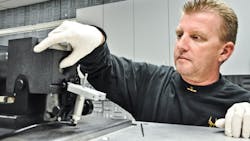Expansion Management: A Strong Workforce is the Key Factor for California Location
Ranked at #32 on the list of business-friendly states, California might not necessarily be the first choice to locate a manufacturing plant. Sometimes, though, the quality of the workforce is enough to overcome less than favorable business conditions.
Case in point: Safariland Group, headquartered in Ontario, Calif., which manufactures protective products and equipment including armor, duty gear and firearms accessories for law enforcement and the military. “We are here due to the excellent available workforce,” Safariland’s President Scott O’Brien admits.
See Also: Manufacturing Plant Site Location Strategies
As to why the workforce is so desirable, O’Brien points to internal factors. “We have a very strong culture of improvement which is driven, in large part by the programs we offer,” he says. “People appreciate that the company cares enough to provide training.”
Government support has been important to Safariland. The company’s headquarters was built with aid from the state as well as the city of Ontario through redevelopment bonds. And the training program that the company used to increase both productivity and retention is a state program called the Employment Training Panel (ETP). It provides financial assistance to California businesses to support customized worker training in an effort to attract and retain businesses.
“We started our program with basic skills and grew into supervisory and eventually leadership training,” says Adam Goldman, vice president of Human Resources for Safariland. The company recently graduated almost 30 employees from its leadership program.
For the past two years Safariland has been working with Chaffey College, a public community college in San Bernardino County, that helps employers secure ETP funds.
“Chaffey College helped navigate the state process for us,” says Goldman. “They provided a way for us to comply with the requirements of the program.
The college also worked very closely with the company on creating training that was particular to Safariland’s needs but fit within the core curriculum of the school. Employees can receive technical certifications, quality control classes and leadership classes. All are done during work hours. If employees complete the course work, there is no cost to Safariland. “It really is a free lunch,” says Goldman.
However the “free lunch” was supported by management efforts to drive continuous improvement throughout Safariland. O’Brien did a road show across the company, which is comprised of 1,700 employees at five locations. He stressed the three pillars upon which his company’s improvement efforts stand: culture, competency and continuous improvement.
“When we help our employees become better leaders, there is a trickle-down effect,” O’Brien explains. “The benefits of training become contagious. It’s a positive inertia around learning, thinking and doing things differently. Simply by talking, engaging and teaching people, everyone becomes more focused on process improvement. Moreover, we’ve seen an increase in performance and reduced turnover.” Over the past five years, turnover moved from numbers in the mid-teens to single digits.
The concept of lean is very familiar to Safariland, in part due to serving the automotive sector. It supplies accessory parts to major OEMs including Toyota (IW 1000/8), and employees have been trained in the Toyota Production System. In fact this year the company won the Toyota Quality Alliance Gold Supplier Award.
Lean and its objective of improving daily is a belief that O’Brien strongly embraces.
“One of the things I say as I sign off town hall meetings, is that everyone will get a little better every day,” O’Brien says. “At end of the year we are a lot better and individually everyone adds value.”
The value employees add is brought home through the company’s mission statement: “Together We Save Lives.”
The mission is personal to Safariland’s employees. The company has chronicled over 1,833 individuals whose lives have been saved in part through using their products.
Recently an enforcement office held his three-month-old baby in his arms during a factory visit. He explained that the armor he wore when he was shot saved his life and enabled him to live to see his baby being born.
